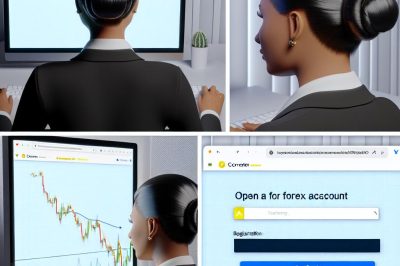Understanding Forex Accounts
To begin trading in the foreign exchange market, the first step is to open a forex trading account. This process involves several important considerations and steps that one must follow to effectively manage forex trades. Here’s a comprehensive guide to help you through this process.
Choosing a Reliable Forex Broker
Choosing the right broker is a key step that directly impacts your trading experience and potential success. Therefore, conducting thorough research on various brokers is essential. This involves comparing their services, regulations, fees, and reputation.
Regulation
Ensure that the broker you choose is regulated by a recognized financial authority. This includes reputable bodies like the Financial Conduct Authority (FCA) in the UK or the U.S. Commodity Futures Trading Commission (CFTC). Trading with a regulated broker provides a level of security and trust, ensuring that your trades are conducted in a legal and ethical manner.
Trading Platform
Evaluate the trading platform offered by the broker. The platform should be user-friendly and feature-rich, allowing for seamless execution of trades. Look for features such as charting tools, indicators, and real-time data access. A reliable platform plays a crucial role in executing trades efficiently and effectively.
Customer Support
Access to prompt and effective customer service is vital. It helps you quickly resolve any trading or account issues. Consider the availability and responsiveness of the broker’s customer support team, as well as the channels through which you can contact them, such as live chat, phone, or email.
Types of Forex Accounts
Forex brokers typically offer different types of accounts. It’s important to choose one that suits your trading needs and financial capacity. Here is a brief overview of some common account types available to traders:
Standard Account
This type of account is typically suited for experienced traders due to its higher initial deposit requirements. A standard account provides greater flexibility in terms of leverage and trade sizes, which can be advantageous for those familiar with forex trading dynamics.
Mini/Micro Account
Ideal for beginners, mini or micro accounts require a lower initial deposit. They allow smaller trade sizes, making them perfect for those who are new to trading or wish to test strategies without risking significant amounts of capital.
Managed Account
For individuals who prefer not to manage their own trades, a managed account is an attractive option. Here, professional traders manage the trades on your behalf, though this comes at an additional cost. It’s a viable choice for those lacking time or expertise but wishing to participate in the forex market.
Necessary Documentation
Once you have selected a broker and account type, the next step is preparing and submitting essential documentation. This is crucial for identity verification to comply with regulatory requirements. Generally, you will need the following:
Proof of Identity
This typically includes a valid passport or driver’s license. Providing proof of identity ensures that your trading account is legally bound to you and helps prevent fraudulent activity.
Proof of Address
Documents like utility bills or bank statements serve as proof of residence. Ensuring that the proof of address is recent (usually within the last three months) is important as part of the verification process.
Funding Your Account
Before you can begin trading, you need to deposit funds into your forex account. Brokers offer various methods for this, including bank transfers, credit/debit cards, and online payment systems like PayPal. Understanding the broker’s deposit and withdrawal policies is essential. This includes being aware of any associated fees or limits that could impact your trading activities.
Practicing with a Demo Account
Before you dive into live trading, it’s wise to practice on a demo account. A demo account allows you to familiarize yourself with the trading platform and develop your trading strategies without the risk of losing real money. This practice environment helps build confidence and fine-tune your skills before engaging in real-time trading.
Initiating Live Trading
Once you’re comfortable with the platform and have honed your strategies, you can switch to live trading. Start with small trade sizes to manage risk effectively, and gradually increase your trade sizes as you gain more experience and confidence. Starting conservatively helps in mitigating potential losses while you continue to develop as a trader.
Legal Considerations
It’s crucial to read and understand the broker’s terms and conditions. This includes understanding the legal bindings and obligations associated with maintaining a forex trading account. Consulting with a financial advisor or legal professional can provide clarity on complex terms and ensure you’re making informed decisions.
For further guidance and updates on forex trading, it might be beneficial to explore resources such as Investopedia or follow professional trading forums. These platforms provide valuable insights into market trends, strategies, and broker evaluations. Additionally, exploring further resources can enhance your knowledge about the forex market; you may wish to visit this site for more comprehensive insights.





